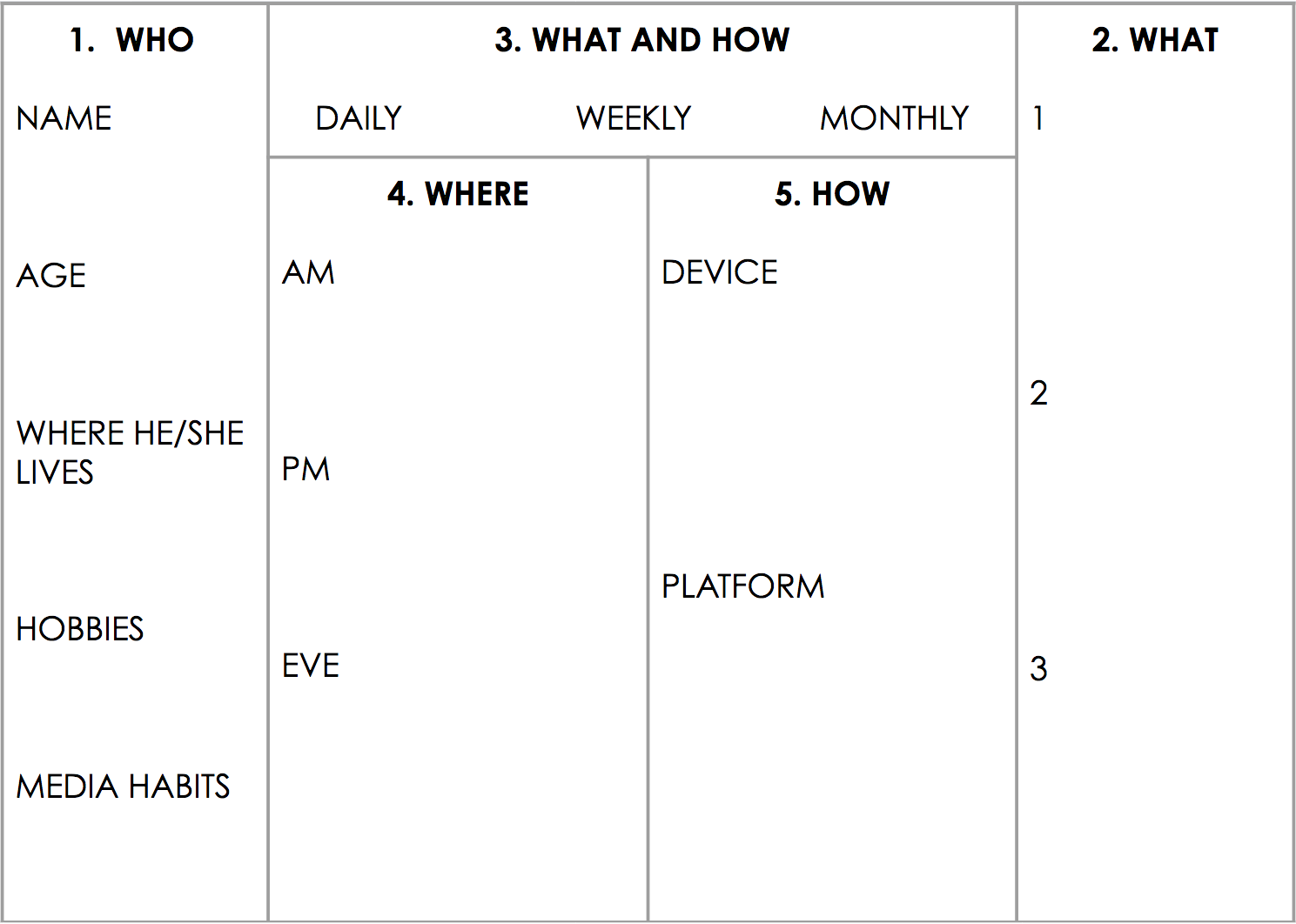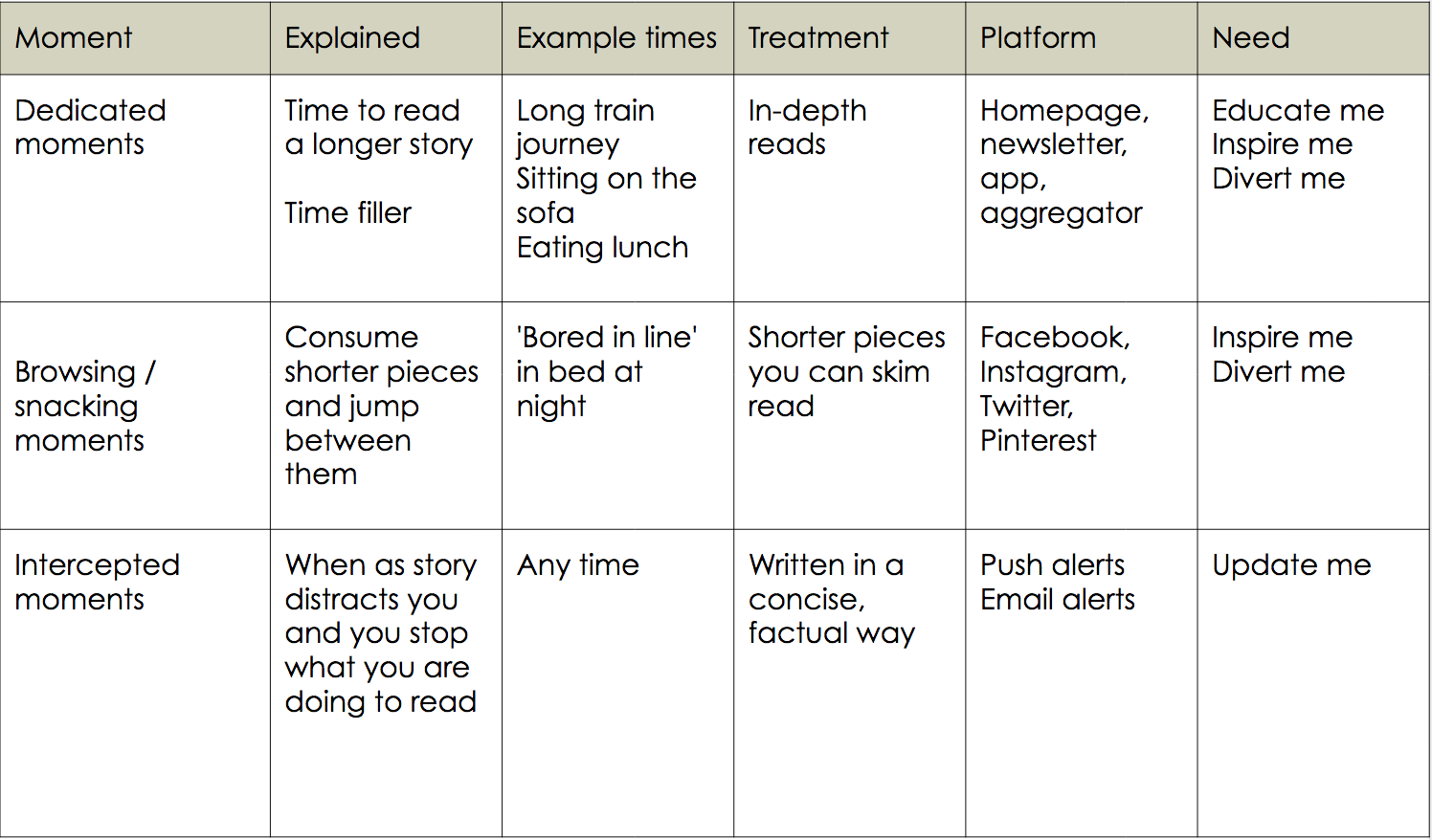
Have you heard of the lean canvas? It is a single-page template designed to distil the fundamental goals and objectives of a business, and offer a clear route to achieving them.
It maps out ways to design a product around perceived market and consumer variables — and unlike lengthy business plans, it is supposed to take around 20 minutes to complete.
In about 45 minutes at a workshop at Newsrewired (27 November 2019), journalists learned how to apply this framework to their news organisation’s editorial and business strategy.
Sarah Marshall, head of audience growth at Vogue Global Network led the workshop by providing an adapted model for journalists called 'audience canvas'. This tool can be used to better understand who your typical target audience is and what types of news content would resonate the most. News organisations can then understand how and when to deliver this to their readers and listeners to secure their long-term loyalty.
The canvas is divided into five sections:

1. Who is your reader?
First, you need to picture a typical reader. For this exercise, we were given a photograph of a person and were tasked to start profiling their character into name, age, location, hobbies and media habits.
In theory, any news organisations can start to profile from a set of working assumptions for a typical reader (or use qualitative interviews like Vogue Global Network does) to understand dominant hobbies and media habits of their readers.
In our example, we named our character Lana, a 25-year-old fashion-fanatic from east London. Her bold fashion statements were a slight giveaway to those interests and as she was clutching (what looked to be) an iPhone, we also assumed she was social-media-savvy. She was probably an Instagram user, or maybe even posting on YouTube.
She may be interested in wider arts, like photography or music. She could have also been a whizz at Adobe Photoshop. Her demeanour was also somehow distinctly professional as if she was very career-minded and goal-driven.
2. What content appeals to them?
From there, you can start asking the question: what type of content matters to their life? For Lana, quite clearly, she wants to stay abreast of new fashion trends and is probably always looking for new inspiration.
Thinking about her career goals, does she also want to know about professional advice and ways to boost her social media presence? And if we also assume she is interested in, say, the music industry, would she care about a local event listing?
Any news organisation should ask themselves to name three types of content that would matter to their everyday readers.
3. Where content meets lifestyle
Think about Lana's three demands: style inspirations, career advice and latest events. How often will she go looking for that content based on what we have deduced about her? You can only pick from daily, weekly or monthly.
She might be looking for the next season's range daily, but she might only actively seek out career advice once a month. How often does Lana want to know about upcoming events? Perhaps somewhere in between, like once a week.
What about your audiences? How often will they go looking for the content that you now know they want?
4. A day in the life of your reader
Next, journalists were asked to step into their readers' shoes and map their movements from morning till night. What does their day-to-day lifestyle look like?
For Lana, does her choice of white trainers reveal something athletic about her? If so, does she go for a morning run or stretch out with some yoga?
We worked on the assumption that she worked freelance in the media industry, maybe in graphic design or photography. Her week is tightly scheduled but she is not tied to a nine-to-five. She works from home and spends the morning working on various projects, in between making calls and checking emails.
There is time for life admin throughout the day, but she will need to venture out of the house periodically for meetings and photography shoots. So she travels a lot, probably on public transport. Her evenings consist of self-care and unwinding though, so if there are local venues, which is pretty much guaranteed in London, she could be persuaded to go there every now and again.
As a journalist, have you ever stopped to think about your audience and the life they lead? If you make a few assumptions (or get a more accurate picture from speaking to them), it will paint a picture of who it is you are trying to cater to and where you slot into their lives.
5. What devices and platforms are they always using?
By now, you will have come to know your imaginary - or perhaps real - reader. Technology is key for consuming news, so journalists need to understand what physical and digital platforms their readers are used to using - there is no point serving content on a platform they do not use, as you will not be discovered. What do they use on a daily basis?
Lana is clearly smartphone literate - she was holding one in the picture. We assumed Instagram is a frequent destination for her.
She uses her iPhone regularly to make calls for work and has a variety of apps for a range of purposes. She has a Facebook account for connecting with friends, and a LinkedIn account for professional connections. She also probably has some editing apps for social media.
For work, she will probably need a laptop and we are thinking Macbook. She is familiar with a lot of Adobe products.
What about your audiences? What technology do you think they come into contact with daily? Where are the hotspots that you can strive to appear on?
I’m running a workshop - and making people use their brains... ‘Audience canvas: Creating an audience-first strategy’ at #newsrewired pic.twitter.com/4Zvf2DlS5U
— Sarah Marshall (@SarahMarshall) November 27, 2019
Applying it all to an editorial strategy: verticals, news moments and distribution platforms
So now you have a basis to work from. You have a reader either in the flesh or in your mind. You know their profile, commitments, interests, habits and technical literacy.
Let us re-cap: Lana is our fashion-focused reader. She works in photography or graphic design and is focused on her career. She is a freelancer and has a strong understanding of digital and social media.
This is where your creativity starts kicking in. You need to apply that information to a set of editorial strategies to plan how you can best meet those lifestyle considerations.
Verticals
Start with 'verticals', also called overarching news topics. Consider them like sections on a website or magazine. You often see these as 'culture' or 'careers' and so on.
News moments
Next, we come onto the idea of 'news moments' - the specific scenario that the audience allocates for news consumption. This idea came out of the Digital News Report 2019 by Reuters Institute for the Study of Journalism.
Senior research associate, Nic Newman detailed these as dedicated moments (less frequent, deeper understanding), updated moments (more regular necessity), time-filler moments (browsing or 'snacking' activity while doing something else), intercepted (interrupted at any time and anywhere).
Combining the ideas from the BBC’s six user needs (inspire me, divert me, educate me, keep me on trend, update me and give me perspective), journalists must think about where the verticals correspond to those opportunities for news moments.

Platforms
The final part of the equation revolves around which platform would best deliver the combination of the two. Think back to the platforms that your reader is familiar with and come up with distribution channels that would make sense for the vertical and at the time they would consume it, and what purpose it would achieve.
The combined effect is knowing what a reader wants to read and why, creating strategies to deliver that in a way that is both accessible to their lifestyle needs and applicable to their technical ability.
For Lana, who wants fashion inspiration - exactly 'inspire me' - we created a fashion vertical for her commutes. She will likely be flicking through Instagram on her iPhone and our idea is to fill that browsing moment with a piece of inspiration that she will remember.
Alternatively, for career-minded content, is she going to go out of her way every day to get this content? Probably not, she is much more likely to have a newsletter subscription for this. When she is checking her emails in her everyday routine, something will catch her eye. Our idea is to get her to save this stand-out article for those dedicated moments where she wants to be educated.
Tailor-made story ideas
With those insights in mind, how can you and your news organisation create specific story ideas which play into those scenarios? What about 'How to style your wardrobe' on Instagram Stories, or 'Ten tips to boost your YouTube subscriber base' on a newsletter update.
If Lana is just flicking by on Instagram and comes across these stories, you are much more likely to have secured a strong first impression and put her on the path to becoming a loyal reader. If she is already signed up to your newsletter, providing this steady flow of relevant content will retain her loyalty for the long term, too.
The possibilities are, potentially, endless. But by working out some rough parameters you can start to hone in on content that has a good chance of appealing, and avoid running with ideas that could be wide of the mark. In just 45 minutes, you could have a roadmap for rapid audience growth.
Further resources:
Want to give it a go? Take a look at the Google document Marshall has provided below:
For those who were in the workshop I led at #newsrewired, here is the 'audience canvas'. You are welcome to take it back to your newsroom and use it to create an audience-first strategy. https://t.co/SFBiix5qM1
— Sarah Marshall (@SarahMarshall) November 27, 2019
Free daily newsletter
If you like our news and feature articles, you can sign up to receive our free daily (Mon-Fri) email newsletter (mobile friendly).
Related articles
- Join us at the Newsrewired conference on 22 May 2024
- How NRK uses AI-generated summaries to boost younger readers’ engagement
- Seán Wood, CEO of Positive News, on fighting news avoidance
- Trust is not a "useless metric" - we just need to understand it better
- New playbook to help publishers boost content strategy









